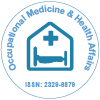Aging Population: Challenges and Opportunities in a Changing World
Received: 01-Mar-2025 / Manuscript No. omha-25-170281 / Editor assigned: 03-Mar-2025 / PreQC No. omha-25-170281 / Reviewed: 17-Mar-2025 / QC No. omha-25-170281 / Revised: 22-Mar-2025 / Manuscript No. omha-25-170281 / Published Date: 29-Mar-2025
Introduction
Introduction
The world is witnessing a significant demographic shift: the rapid growth of the aging population. Advances in healthcare, nutrition, and living standards have led to longer life expectancies, resulting in an increasing proportion of people aged 60 and above. According to the World Health Organization, by 2050, the number of people over 60 is expected to double, reaching over 2 billion globally [1],[2]. While this shift reflects positive progress in human development, it also presents complex social, economic, and healthcare challenges that societies must address.
Discussion
An aging population impacts nearly every aspect of society. One of the most immediate concerns is the strain on healthcare systems. Older adults often face chronic health conditions such as heart disease, arthritis, diabetes, and cognitive decline. This increases the demand for long-term care, geriatric specialists, and support services. Many health systems are not fully equipped to manage this growing need, leading to gaps in care and increased pressure on hospitals, caregivers, and families [3],[4].
Economically, an older population affects labor markets and pension systems. As more people retire, the workforce shrinks, potentially slowing economic growth and increasing the burden on younger generations to support social welfare programs. Governments must find sustainable ways to balance pension funds, encourage longer working lives, and promote age-inclusive policies [5],[6].
Socially, aging can lead to isolation and mental health challenges. Many elderly individuals live alone or in care facilities, with limited social interaction. Loneliness and depression are common, yet often overlooked. Community-based programs, intergenerational activities, and digital inclusion initiatives can help older adults stay connected and mentally active [7],[8].
Despite these challenges, an aging population also brings opportunities. Seniors today are living longer and often more actively than previous generations. Many are willing and able to contribute to society through volunteering, mentoring, or part-time work. Recognizing their value and experience can benefit communities and strengthen social bonds.
Technological advancements also offer promising solutions. Telemedicine, wearable health devices, and smart home systems are helping older adults manage their health independently. Assistive technologies and mobility aids enhance quality of life and reduce dependence on caregivers. As innovation continues, technology can play a vital role in addressing age-related limitations.
Additionally, urban planning and infrastructure must evolve to become more age-friendly. This includes accessible public transport, safe walking paths, healthcare access, and recreational spaces designed with older adults in mind. Creating inclusive environments benefits not only the elderly but people of all ages [9],[10].
Conclusion
The aging population is a defining feature of our time. While it presents real challenges in healthcare, economics, and social integration, it also offers unique opportunities to harness the experience and wisdom of older generations. Societies that proactively plan for aging—by investing in health systems, adapting policies, and embracing innovation—can ensure that growing older is not seen as a burden, but as a stage of life that is active, respected, and valued. Preparing today for the needs of tomorrow’s seniors is essential for building inclusive and sustainable communities for all.
References
- Silalahi AP (2022) A Conceptual Framework for Integrating QSHE in Construction. EACEF Conference 2-10.
- Masuin R (2019) Development of knowledge management in integration management systems in order to increase the organisational performance of construction companies. MATEC Web of Conferences 1-10.
- Ahidar I (2018) Approach to Integrating Management Systems. The TQM Journal 183- 204.
- Carvalho K (2015) Benefits in the Implementation of Safety, Health, Environmental and Quality Integrated System. IACSIT Int J Eng Technol 7: 1-5.
- Institution of Civil Engineers (2020) CDM 2015: 3 years on Assessing the Construction (Design & Management). London: Institution of Civil.
- HSE (2021) Workplace Fatal Injuries in Great Britain. London: Crown.
- Henjewele (2019) Construction Project Management An Integrated Approach Third Edition. New York: Routledge.
- Rumane (2018) Quality Management in Construction Projects Second Edition. Boca Raton: Taylor & Francis Group.
- CONIAC (2015) CDM 2015 - Industry Guidance for Clients. Norfolk: CITB.
- Rebelo MF (2014) A generic model for integration of quality, environment and safety management systems. TQM Journal January 683-701.
Citation: Leon W (2025) Aging Population: Challenges and Opportunities in a Changing World. Occup Med Health 13: 572.
Copyright: © 2025 Leon W. This is an open-access article distributed under the terms of the Creative Commons Attribution License, which permits unrestricted use, distribution, and reproduction in any medium, provided the original author and source are credited.
Select your language of interest to view the total content in your interested language
Share This Article
Recommended Journals
Open Access Journals
Article Usage
- Total views: 187
- [From(publication date): 0-0 - Nov 09, 2025]
- Breakdown by view type
- HTML page views: 130
- PDF downloads: 57
